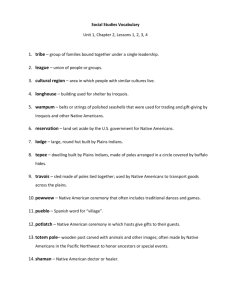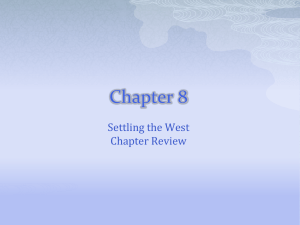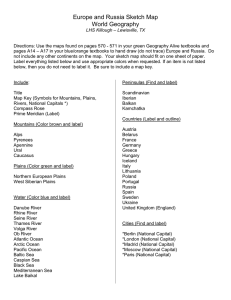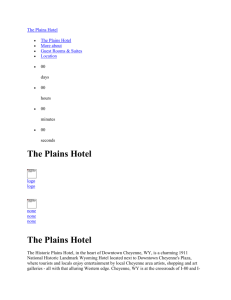Research at the High Plains Grasslands Research Station D. T. Booth
advertisement
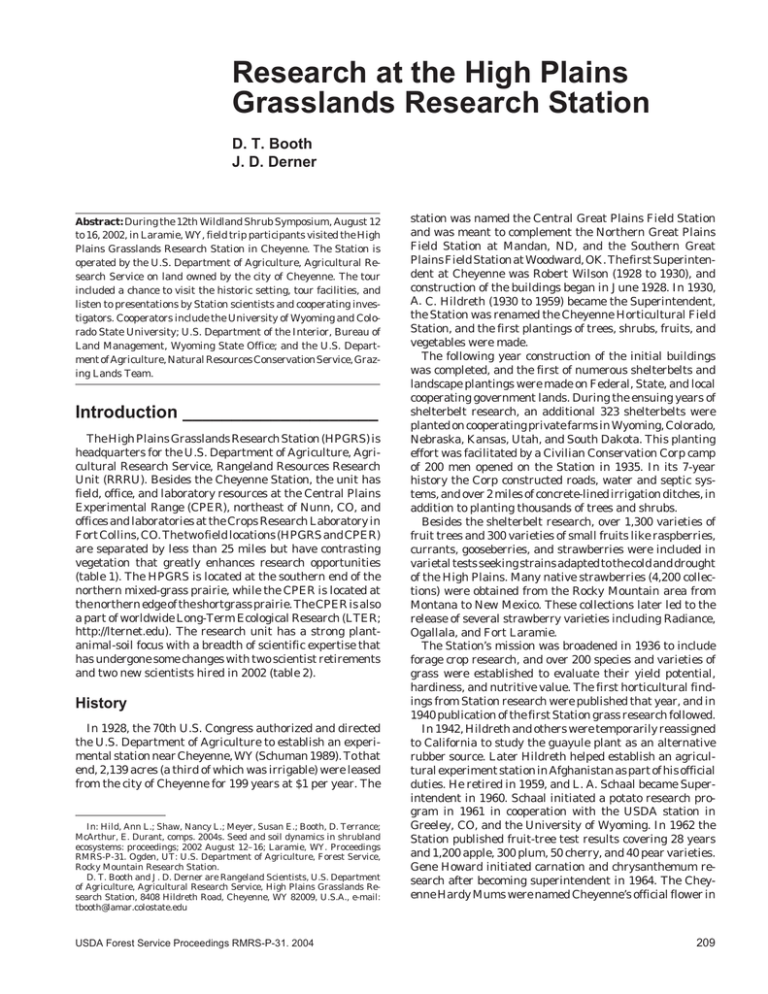
Research at the High Plains Grasslands Research Station D. T. Booth J. D. Derner Abstract: During the 12th Wildland Shrub Symposium, August 12 to 16, 2002, in Laramie, WY, field trip participants visited the High Plains Grasslands Research Station in Cheyenne. The Station is operated by the U.S. Department of Agriculture, Agricultural Research Service on land owned by the city of Cheyenne. The tour included a chance to visit the historic setting, tour facilities, and listen to presentations by Station scientists and cooperating investigators. Cooperators include the University of Wyoming and Colorado State University; U.S. Department of the Interior, Bureau of Land Management, Wyoming State Office; and the U.S. Department of Agriculture, Natural Resources Conservation Service, Grazing Lands Team. Introduction ____________________ The High Plains Grasslands Research Station (HPGRS) is headquarters for the U.S. Department of Agriculture, Agricultural Research Service, Rangeland Resources Research Unit (RRRU). Besides the Cheyenne Station, the unit has field, office, and laboratory resources at the Central Plains Experimental Range (CPER), northeast of Nunn, CO, and offices and laboratories at the Crops Research Laboratory in Fort Collins, CO. The two field locations (HPGRS and CPER) are separated by less than 25 miles but have contrasting vegetation that greatly enhances research opportunities (table 1). The HPGRS is located at the southern end of the northern mixed-grass prairie, while the CPER is located at the northern edge of the shortgrass prairie. The CPER is also a part of worldwide Long-Term Ecological Research (LTER; http://lternet.edu). The research unit has a strong plantanimal-soil focus with a breadth of scientific expertise that has undergone some changes with two scientist retirements and two new scientists hired in 2002 (table 2). History In 1928, the 70th U.S. Congress authorized and directed the U.S. Department of Agriculture to establish an experimental station near Cheyenne, WY (Schuman 1989). To that end, 2,139 acres (a third of which was irrigable) were leased from the city of Cheyenne for 199 years at $1 per year. The In: Hild, Ann L.; Shaw, Nancy L.; Meyer, Susan E.; Booth, D. Terrance; McArthur, E. Durant, comps. 2004s. Seed and soil dynamics in shrubland ecosystems: proceedings; 2002 August 12–16; Laramie, WY. Proceedings RMRS-P-31. Ogden, UT: U.S. Department of Agriculture, Forest Service, Rocky Mountain Research Station. D. T. Booth and J. D. Derner are Rangeland Scientists, U.S. Department of Agriculture, Agricultural Research Service, High Plains Grasslands Research Station, 8408 Hildreth Road, Cheyenne, WY 82009, U.S.A., e-mail: tbooth@lamar.colostate.edu USDA Forest Service Proceedings RMRS-P-31. 2004 station was named the Central Great Plains Field Station and was meant to complement the Northern Great Plains Field Station at Mandan, ND, and the Southern Great Plains Field Station at Woodward, OK. The first Superintendent at Cheyenne was Robert Wilson (1928 to 1930), and construction of the buildings began in June 1928. In 1930, A. C. Hildreth (1930 to 1959) became the Superintendent, the Station was renamed the Cheyenne Horticultural Field Station, and the first plantings of trees, shrubs, fruits, and vegetables were made. The following year construction of the initial buildings was completed, and the first of numerous shelterbelts and landscape plantings were made on Federal, State, and local cooperating government lands. During the ensuing years of shelterbelt research, an additional 323 shelterbelts were planted on cooperating private farms in Wyoming, Colorado, Nebraska, Kansas, Utah, and South Dakota. This planting effort was facilitated by a Civilian Conservation Corp camp of 200 men opened on the Station in 1935. In its 7-year history the Corp constructed roads, water and septic systems, and over 2 miles of concrete-lined irrigation ditches, in addition to planting thousands of trees and shrubs. Besides the shelterbelt research, over 1,300 varieties of fruit trees and 300 varieties of small fruits like raspberries, currants, gooseberries, and strawberries were included in varietal tests seeking strains adapted to the cold and drought of the High Plains. Many native strawberries (4,200 collections) were obtained from the Rocky Mountain area from Montana to New Mexico. These collections later led to the release of several strawberry varieties including Radiance, Ogallala, and Fort Laramie. The Station’s mission was broadened in 1936 to include forage crop research, and over 200 species and varieties of grass were established to evaluate their yield potential, hardiness, and nutritive value. The first horticultural findings from Station research were published that year, and in 1940 publication of the first Station grass research followed. In 1942, Hildreth and others were temporarily reassigned to California to study the guayule plant as an alternative rubber source. Later Hildreth helped establish an agricultural experiment station in Afghanistan as part of his official duties. He retired in 1959, and L. A. Schaal became Superintendent in 1960. Schaal initiated a potato research program in 1961 in cooperation with the USDA station in Greeley, CO, and the University of Wyoming. In 1962 the Station published fruit-tree test results covering 28 years and 1,200 apple, 300 plum, 50 cherry, and 40 pear varieties. Gene Howard initiated carnation and chrysanthemum research after becoming superintendent in 1964. The Cheyenne Hardy Mums were named Cheyenne’s official flower in 209 Booth Research at the High Plains Grassland Research Station Table 1—Characteristics of research field locations. Characteristics High Plains Grasslands Research Station Cheyenne, WY Central Plains Experimental Range Nunn, CO Size Annual precipitation Rangeland type Annual production 2,870 acres 14.6 inches Mixed-grass prairie 1,380 pounds per acre 15,500 acres 12.8 inches Shortgrass prairie 625 pounds per acre Table 2—High Plains Grasslands Research Station scientists and field of expertise. Name Jack Morgan Gerald Schuman Terrance Booth Jean Reeder Justin Dernera Dana Blumenthala Richard Hart, retired Gary Frasier, retired a Title Plant Physiologist Soil Scientist Rangeland Scientist Soil Scientist Rangeland Scientist Weed Ecologist Agronomist Hydrologist Carbon and water fluxes, global climate change Carbon sequestration, reclamation of degraded lands Revegetation, remote sensing for rangeland monitoring Nutrient cycling, belowground processes, carbon sequestration Rangeland monitoring and health, grazing management Invasive species, global change Grazing management Rangeland hydrology Newly hired. 1970. Then in 1974 Howard had the task of terminating the horticultural research program—fruits, flowers, vegetables, and shelterbelts—and of developing a program directed toward grazing management, water conservation, and minedland reclamation. As part of the program redirection the Station was renamed the High Plains Grasslands Research Station and several new staff members were added. Richard Hart became Location Leader (Superintendent) in l976, and the first papers derived from the Station’s new grassland research mission were published. Additional land was acquired from F. E. Warren Air Force Base, enabling further development of livestock grazing research. In 1981, Gerald Schuman became the Location Leader and continued in that capacity until 1998. During that time grazing management and mined-land reclamation were the predominant research activities, and research findings contributed to improved stocking rate recommendations for rangelands, and to increasingly successful techniques for mined land reclamation. Jack Morgan assumed leadership responsibilities in 1998 and implemented new research with a focus on carbon sequestration, rangeland monitoring and health, management strategies for mitigation of global climate change, and invasive species. New Changes to Meet the Challenges of the Twenty-First Century ________________________ Rangeland monitoring and health, invasive species, and improved land management strategies will be the primary research foci for the HPGRS in the early part of the new 210 Research century. Research will continue to target systems-level questions that are pertinent to both private and public land issues (grazing, revegetation, weed management), but these practices will be addressed in the context of the ecological system and sustaining rangeland health. While research will continue at the HPGRS and CPER field sites, Station scientists will expand their research into the sagebrush steppe vegetation that is prominent throughout much of Wyoming. New research projects targeted to address public lands questions pertinent to the sagebrush steppe vegetation include determining above- and belowground carbon budgets following changes in land management and utilizing very large scale aerial (VLSA) imagery as a method to assess and monitor vegetation change. The High Plains Grasslands Research Station has a long history of providing practical information for land managers and of reacting to the needs of local, State, and national customers. To this end, HPGRS scientists will continue to investigate innovative approaches to land management that combine emerging technologies and customer-oriented products. Our mission is to learn how plants, soil, water, atmosphere, weather, and management interact on grazing lands, and to use the resulting knowledge to promote sustainable and profitable management systems producing desired goods and services. Reference ______________________ Schuman, G. E. 1989. Cheyenne Horticultural Field Station/High Plains Grasslands Research Station. In: Field, S. L., ed. History of Cheyenne, Wyoming-Laramie County. Vol. 2. Dallas, TX: Curtis Media Corporation: 55–56. USDA Forest Service Proceedings RMRS-P-31. 2004 Research at the High Plains Grassland Research Station Booth Appendix A: Agenda for Wildland Shrub Symposium Field Trip to the High Plains Grasslands Research Station__________________________________ Wednesday, August 14, 2002 8:00 a.m. 9:00 9:10 & 10:00 11:20 12:00 1:30 p.m. 2:00 3:00 Leave Laramie and travel to the High Plains Grasslands Research Station via Happy Jack Road Welcome to the High Plains Grasslands Research Station by Jack Morgan, Research Leader Oral presentation in main office building. Plant and animal responses to grazing systems at the High Plains Grasslands Research Station by Justin Derner and Jim Waggoner Poster presentations at picnic area (presenters will be at their posters until 11:20) Elevated CO2 enhances production but reduces forage quality in perennial grasses of the shortgrass steppe - Jack Morgan Influence of livestock grazing on carbon sequestration in a semiarid mixed-grass and short-grass rangelands - Jean Reeder and Gerald Schuman Effect of interseeded Falcata alfalfa on carbon sequestration and production of a mixed-grass rangeland - Gerald Schuman Transplantable container for rangeland shrub revegetation - Terrance Booth Presentation at the airplane: Rangeland monitoring using very large scale imagery - Terrance Booth, Joe Nance, and Sam Cox Break (visit labs, see Seed Growth Robot-2 and Wyoming big sagebrush seed orchard, or visit with staff) Leave the High Plains Grasslands Research Station for Cheyenne’s botanical garden and Lion’s Park. A sack lunch will be served at Lion’s Park followed by a tour of the botanical gardens or just enjoy the park. Leave Lion’s Park for Terry Bison Ranch Arrive Terry Bison Ranch and visit about ranch forage resources and grazing management. Return to Laramie via I-80 USDA Forest Service Proceedings RMRS-P-31. 2004 211


